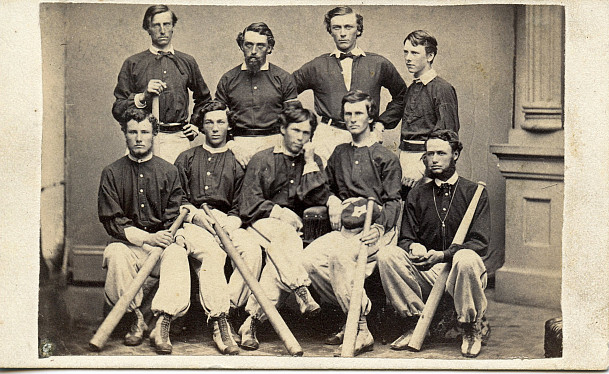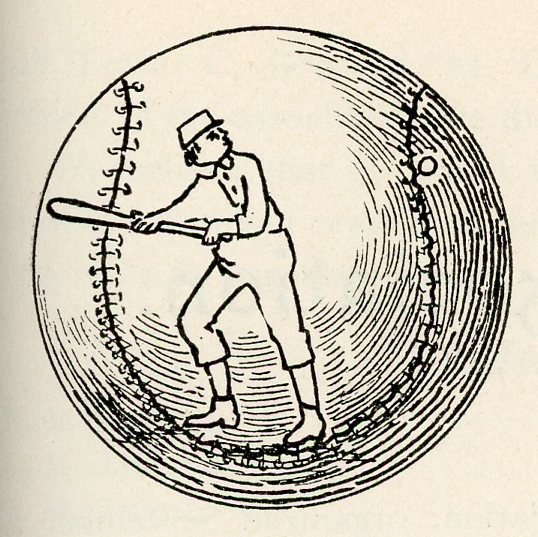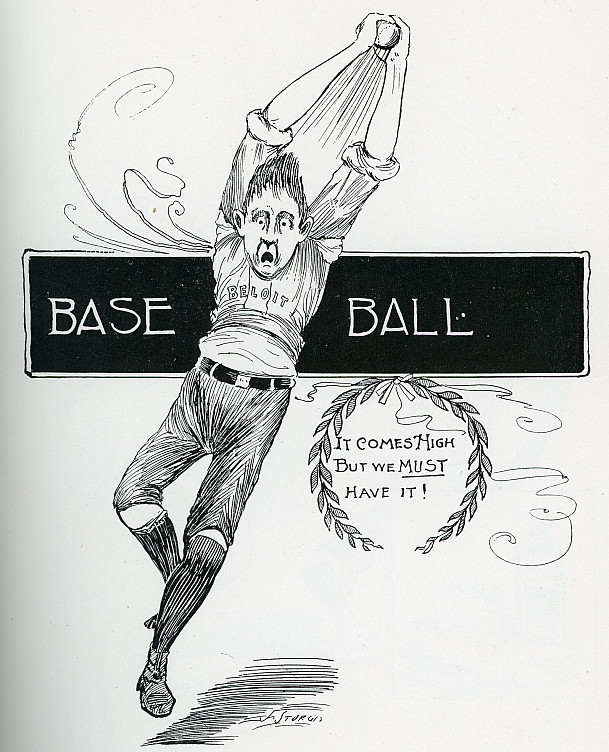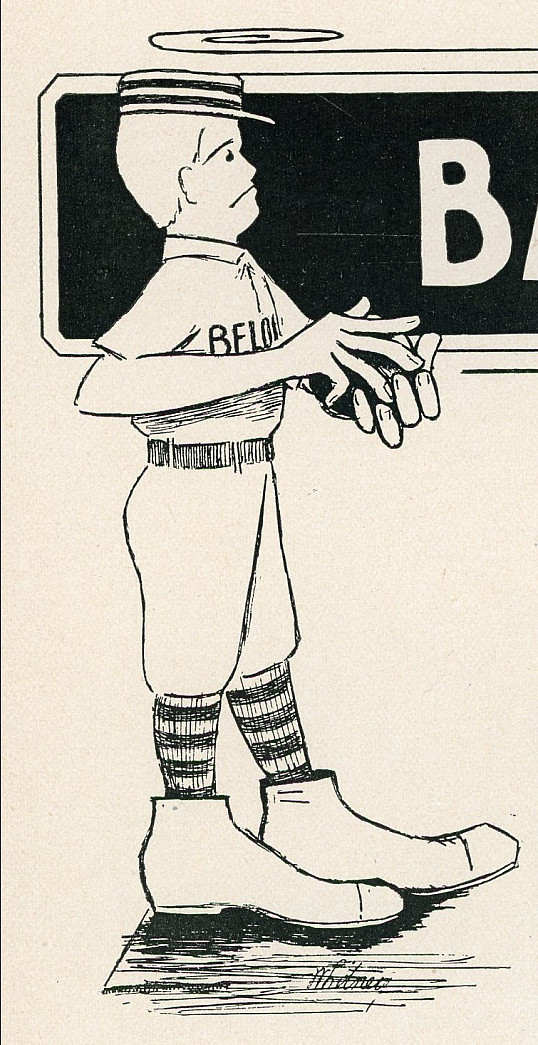Fridays with Fred - Beloit’s First Athletic Team - the Olympian Base Ball Club
It wasn’t the stiff breeze that knocked a professor’s hat off that May day in 1867, but an errant toss of a handstitched leather orb. “Base Ball,” as the Beloit College Monthly declared, was once again “all the rage. The boys may be seen at almost any time of day practicing in throwing and catching.” Their Olympian Base Ball Club had just accepted a challenge from the Whitewater Club for a “match game” to be held on neutral ground in Janesville.

Recreation and sport had always been a part of college life. The Rock River and Turtle Creek drew students for swimming, boating, and fishing. In the winter they skated and tobogganed, and took unauthorized sleighing trips to the Rockford Female Seminary. Ballplaying, including cricket and croquet, became popular, although the college didn’t encourage it. As Professor Henry M. Whitney explained in an 1897 Round Table article, “ballplaying was rough and tumble…There was no intercollegiate competition, for there were few colleges, few students, few railroad facilities, few dollars, and few notions that colleges could compete.”

However, students returning from the Civil War brought a new sport to campus, “New York Base” – or “Base Ball,” and in 1866 they organized the college’s first team, dubbed the Olympian Base Ball Club. Over two seasons, they won most of their matches, all against teams from regional towns and cities. The “ballists” purchased snazzy outfits, white “zouave” pants with red stripes down the sides, red shirts, white shoes, and colorful caps. Their lone photograph depicts a mix of weathered-looking Civil War veterans and fresh-faced youngsters. Some of them clutch huge wooden clubs masquerading as base ball bats.
After a successful first season, the Olympian Club was eager to test its mettle again in 1867. Their contests drew strong interest from citizens in the region and there was strong anticipation for the match against Whitewater, to be held on May 25th. “They are said to be two of the best clubs in the State,” the Janesville Gazette reported, “and we may predict a large attendance of spectators.”

Fortunately, a couple of vivid firsthand accounts of both the game and its aftermath reside in the Beloit College Archives. James L. Foley was a student in the college’s Preparatory Department. According to his diary, May 25th dawned clear, and the students felt restless as they yawned through morning services in the Chapel and Greek recitations with Professor Emerson. At last, they climbed onto their hired omnibus and set off. “We were a jolly set of school-boys…just broke loose from school,” he wrote, “and between singing songs, telling stories, proposing and answering riddles, discussing questions, passing remarks on the various objects on the roadside, the time slipped merrily away.”
After a 40-cent meal at the American House, they proceeded to the ball ground, where the game was just underway, with The Olympians up first. “The game was hotly contested,” Foley wrote, “and for the first few innings it was very doubtful which party would be victorious.” After four innings, the Olympians were ahead, 26-12. “Our boys now played with high hopes of success.”
The “match game” turned into a rout. After nearly four hours of play, Beloit defeated Whitewater, 59 to 19. While today, the result seems like a football score, this was an era when, among many differences, pitchers threw slowly and underhand, fielders did not wear gloves, and players contended with, as Beloit alum and baseball historian, John Thorn, notes, “a rock-hard ball of incredible resiliency.” The Janesville Gazette praised Beloit: “While both clubs played well, the constant practice and training of the Beloit boys manifested itself in every move of the game. In fact they are hard to beat…”
Foley and his fellow students felt jubilant: “We started home a little before sundown and…we began to sing, tell stories, and finally began to hurrah, then to strive with each other to see who could make the most hideous noise…Indeed we made perfect fools of ourselves after coming to town, as we went through the principal streets, shouting like madmen and proclaiming the victory of the Olympians.”

Another baseball-crazy student, James Demarest Eaton, missed the game, but described the celebrations in a letter to his brother, Edward Dwight Eaton, later Beloit’s second president: “We were fearful of the result of the game…At half past nine o’clock P.M. we Baird and I, who were sitting in our room, heard distinctly a cheer, and ran down stairs…and found several loads of students riding into town with noisy demonstrations, and we trotted down to the city to see them. They formed a regular triumphal procession and marched up one street and down another by the gaslights, stopping frequently at the corners to cheer, and we who went on foot helped to swell the sound. If anybody went to bed in Beloit before ten o’clock it is pretty certain that he couldn’t sleep…”
Eaton also touted the game’s importance: “Our club played at Janesville on Saturday with the Whitewater Club – the second in the state and beat them…over three to one, including 5 homeruns and giving three “whitewashes” against none on the other side. The ‘Cream City’ of Milwaukee, the first in this state, beat the latter by but one tally. Wherefore it follows that we are probably the first club in the state! The faculty have just forbidden going out of town to play, and we hope the ‘Cream City’ will challenge us. The challenged party, you know, chooses the field for playing.”
The faculty did indeed ban students from traveling to other towns for ball games, citing “material interference with the proper college duties and the order of the institution.” While they were at it, they fined two students 50 cents each for playing ball in front of the chapel.
Despite faculty eager to put a damper on base ball fever, the Olympians played several more games on their home turf, first defeating Whitewater again and then Madison’s Capital Club. Their greatest challenge, however, awaited them on June 19th. With 5,000 fans on hand at a playing field off campus, they faced the #1 team in the state, Milwaukee’s Cream City Club. James Eaton lamented, “We expect to get beaten, but it will be no disgrace. Their pitcher is hired for a salary!” There was fierce betting over the outcome, with Cream City the clear favorites.
Afterwards, the Janesville Gazette reported that “both clubs played splendidly [but] the Olympians…showed superior playing in all details and minutiae of the game, and all their throwing, catching, knocking and running exhibited their excellent discipline…” The Olympians blasted five home runs, scored 14 runs in the third inning, 11 in the fourth, and crushed the famed Cream City Club, 44-25.
Commenting in the Beloit College Register, later that year, a Beloit College student summed up a season for the ages: “The Base Ball mania has prevailed quite extensively during the year, but has proved fatal to none except visitors. The Olympians have met all of the principal clubs in the State…and not suffered a single defeat. This would not seem to indicate that the students of Beloit are a puny race. No, we develop muscle as well as brains.”
Beloiters – and many others – considered the Olympian Club the champions of Wisconsin base ball.
In July, Beloit College laid the cornerstone of Memorial Hall [now Logan Museum], built to honor men from the college and city who died in the Civil War. Among the items stuffed into the cornerstone time capsule was the battered, grass-stained ball from the glorious Olympian victory over Cream City.
Share:
Open gallery

Related Stories


